Published Jun 1, 2020
Your Guide to Queer Identity and Metaphor in Star Trek
'Star Trek' recently made history with its first gay TV couple – but the road to get there was a long one.
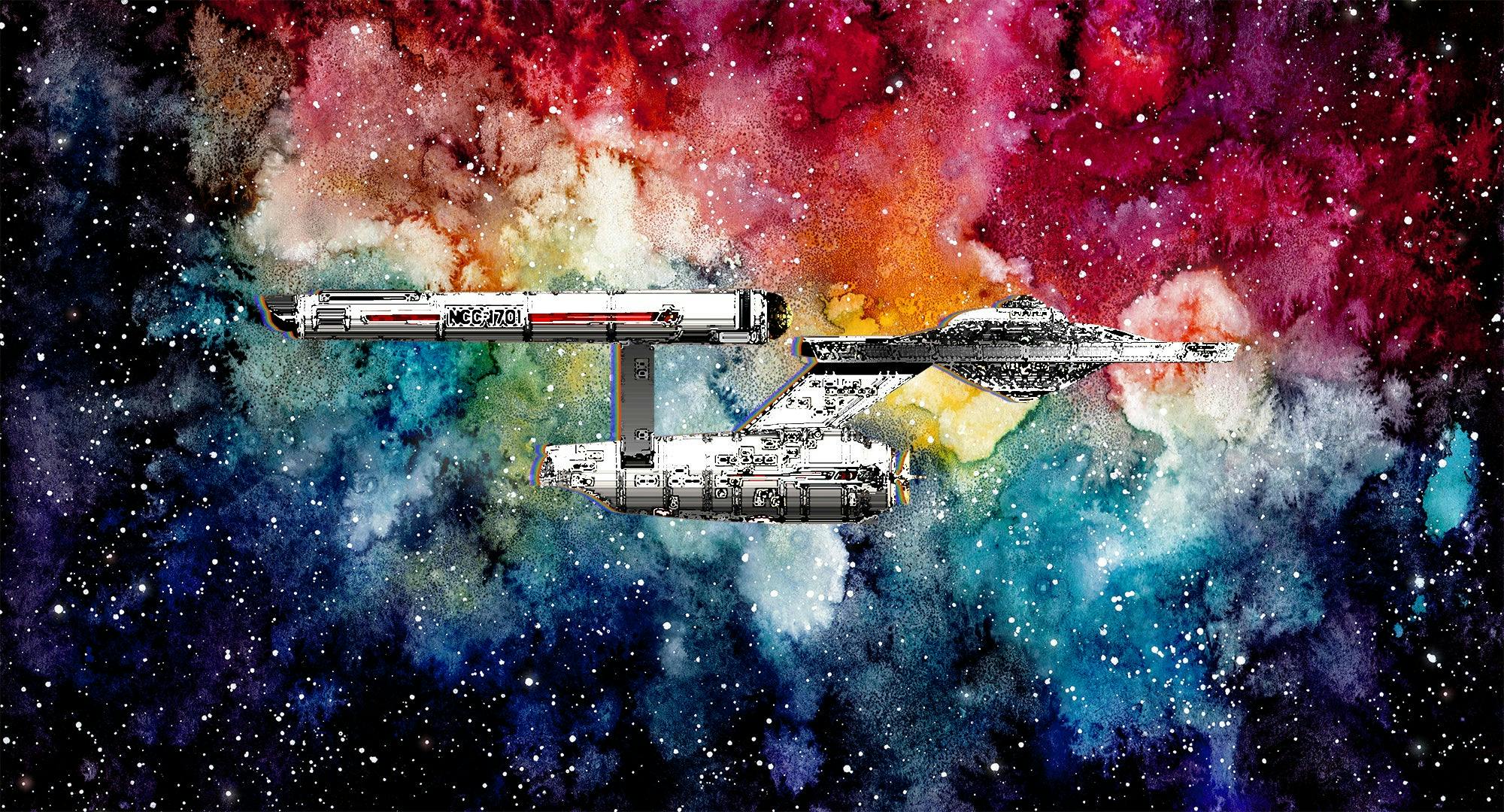
StarTrek.com
Star Trek has always been positioned as a franchise that celebrates humanity’s potential for tolerance and understanding. In many ways, it’s succeeded in that ideal – The Original Series was groundbreaking for its portrayal of people from all different walks of life coming together to explore the stars, and subsequent series have followed suit over the years.
However, like all science fiction, Trek wasn’t handed down to us by an enlightened galactic benefactor; it was created by contemporary people who had their own hangups and prejudices to unpack. Even Gene Roddenberry had to publicly acknowledge the ways in which he had to evolve his thinking over the course of creating the series, especially concerning the LGBT community. “My attitude toward homosexuality has changed,” he told The Humanist in 1991. “I came to the conclusion that I was wrong [...] I gave the impression of being thoughtless in these areas. I have, over many years, changed my attitude about gay men and women.”
Despite Roddenberry’s own admission of bias, the franchise did not immediately go out of its way to correct itself where this type of representation was concerned. Even after his death, it took another 28 years for the first gay character to appear in StarTrek’s television series (although yes, novel tie-ins, comics, fan works, and other non-canonical media featured a markedly improved number of LGBT Starfleet officers). Instead, queer identity was mostly relegated to the world of metaphor, rumor, and interpretation — often from fans and activists who desperately wanted to see themselves in Starfleet.
Star Trek: The Original Series
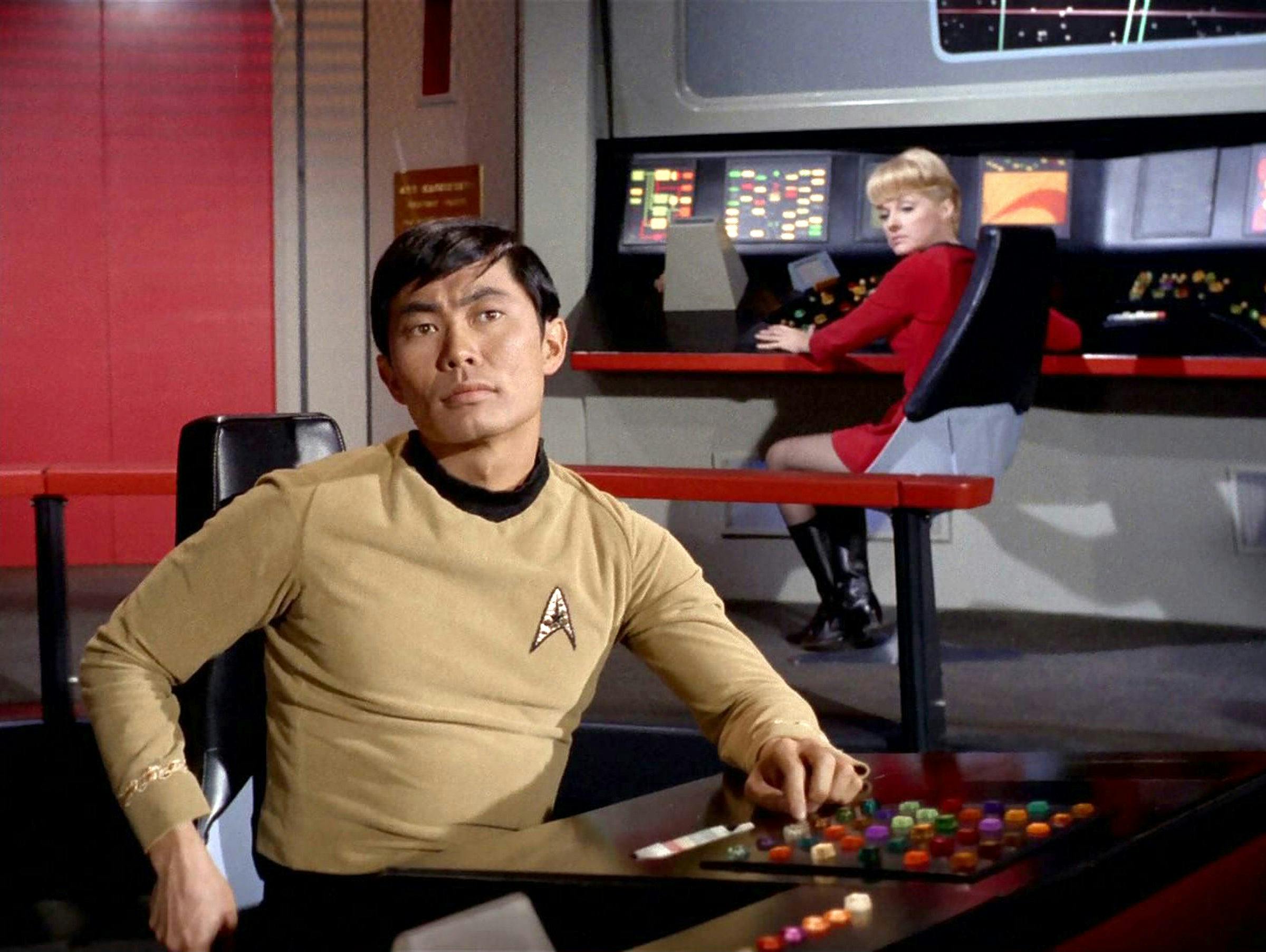
StarTrek.com
Given that the first openly gay recurring character on television wouldn’t appear until the comedy Soap in 1977 (and played by Billy Crystal, so not exactly a nuanced character portrayal), depicting one in the ‘60s when Star Trek first aired would have been unthinkable to most people. Of course, much of what Star Trek did to highlight actors and characters of different ethnic backgrounds would have been pretty far-fetched for many television audiences of the time, too – so what made gay stories different at the time?
Actor George Takei, who himself publicly came out in 2006, often shares the story of speaking with Roddenberry “theoretically” about the prospect of discussing LGBT rights on the show. However, he was told that the timing wasn’t right. “‘All I need is another firestorm and this show will be canceled, and I won't be able to make those statements that I've been making with the show,’” Takei said, echoing Roddenberry’s words in a 2011 Salon interview
In a 2015 video for Big Think, Takei elaborated on this story, implying that it happened at some point after the airing of “Plato’s Stepchildren”:
“In one episode we had a biracial kiss; Captain Kirk and Uhura had a kiss. That show was literally blacked out in the south. Louisiana, Alabama, Mississippi, Georgia didn't air that; our ratings plummeted. It was the lowest-rated episode that we had. And [Roddenberry] said, ‘I'm treading a fine tight wire here. I'm dealing with issues of the time. I'm dealing with the civil rights movement, the Vietnam War, the Cold War and I need to be able to make that statement by staying on the air.’”
Of course, anybody who’s spent any amount of time on the Internet knows that what a television show canonically chooses to represent on screen and what the audience takes away from it can be very different. Star Trek fans, who in many ways pioneered much of what we now consider to be modern fandom, are certainly no exception. Early enthusiasts with access to typewriters and Xerox machines would distribute self-published Star Trek zines to mailing lists around the country, writing their own stories with the characters and using TV film clips and old newspaper clippings to create screen-accurate fanart. Some wrote their own “drawerfics,” which were only meant to be privately shared among friends, but were sometimes spread far and wide against the author’s wishes anyway.

StarTrek.com
One of the best known Star Trek drawerfics-turned-viral-sensations, 1968’s The Ring of Soshern, imagines a scenario (complete with romantic illustrations) where a stranded Kirk and Spock must engage in the Ponn Farr mating ritual to save the Vulcan’s life, and quickly realize that they’ve actually been in ‘capital L’ Love with each other this whole time and didn’t know it. Eventually the term “slash” – coined for the virgule mark in between K/S, or Kirk/Spock – became synonymous with erotic same-gender fanfiction, not just in Star Trek but across other fandoms (like Starsky/Hutch, which, I swear to you, was 100% a real pairing people shipped in the ‘70s.)
Many readers were scandalized by this type of content, claiming that making K/S publicly available would invite Paramount to censor them and destroy the fandom from within (which, according to Judith Gran’s K/S essay, “Censored,” was a concern in both the original ‘70s fandom and the Internet age). But still others were inspired – enough that Kirk and Spock’s enduring connection to one another has remained a potent symbol of homosexual love for Trek fans.
Star Trek: The Next Generation
During a 20th anniversary convention in 1986, show creator Gene Roddenberry was asked by a founding member of a Boston LGBT science fiction group (called, charmingly, the Gaylaxian Network) whether or not the recently announced The Next Generation would introduce gay characters to Starfleet. "[The fan] made the point that Star Trek had been a leader in bringing Black and Asian characters to television, that this was the next step," writer David Gerrold told Salon in 2001. "Gene agreed. He said, 'Sooner or later, we'll have to address the issue. We should probably have a gay character.'"

StarTrek.com
That same year, Gerrold (who’s best known for writing the TOS episode “The Trouble With Tribbles”) began working on a script which revolved around two gay characters becoming afflicted by an incurable, intergalactic blood disease that mirrored the spread of HIV. He hoped the story would raise awareness of the then-ongoing AIDS crisis, and even inspire Star Trek fans to donate their own blood to benefit real-life victims. However, the now-infamous episode, “Blood and Fire,” was never made (save for a fan-made reworking that was produced in 2007 with Gerrold’s blessing), and Gerrold quit the show in protest.
Despite this, Roddenberry still seemed committed to making good on his promise to the Gaylaxians, who by 1990 had begun a letter-writing petition (spurred partly by Gerrold’s stories of his episode’s demise at various convention appearances). In a letter to The Advocate, Roddenberry wrote that "in the fifth season of Star Trek: The Next Generation, viewers will see more of shipboard life in some episodes, which will, among other things, include gay crew members in day-to-day circumstances.” Unfortunately, Roddenberry died unexpectedly in October 1991, and the day-to-day circumstances he envisioned never materialized.
While the show never explicitly made mention of sexual orientation, it did begin to play around with themes of shifting gender. In the Season 3 episode, “The Offspring,” Data creates his own artificially intelligent child and allows her to select her own race and gender presentation; Season’s 4’s “The Host,” introduces the parasitic Trill, who have no gender of their own and who take on the pronouns and gender identity of their hosts instead (and who are effectively pansexual as a result).
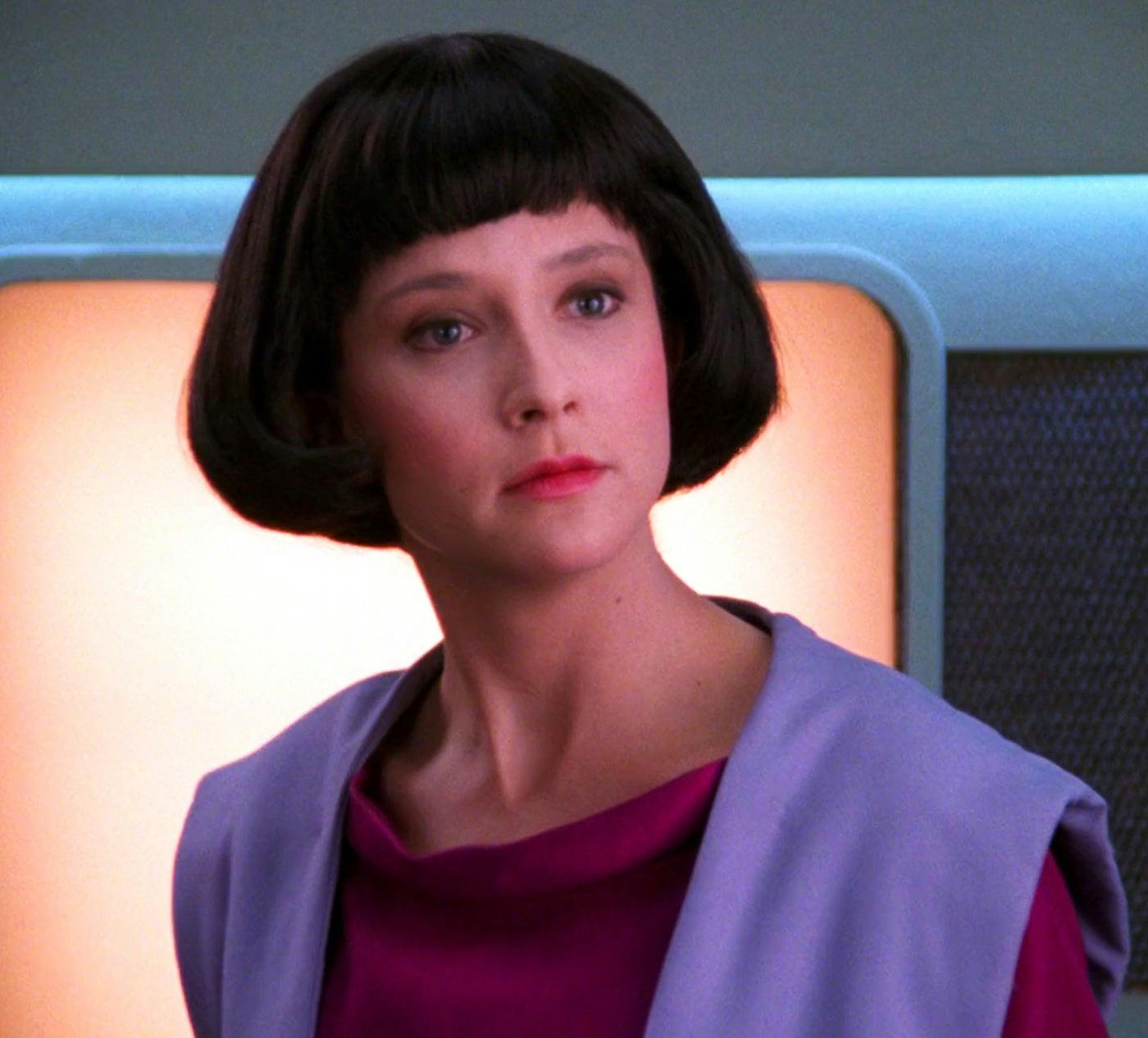
StarTrek.com
The most obvious allegorical LGBT messaging of the series appears in Season 5, in an episode called “The Outcast.” While working with the J’Naii, a rigidly androgynous species, William Riker strikes up a romantic relationship with a J’Naii named Soren, who publicly identifies herself as female and seeks asylum from her people. Despite the oddness of a metaphor for gay rights that involves what is ostensibly a heteronormative couple at the center, Soren’s story is still the closest that ‘90s Star Trek ever came to addressing issues and themes specific to the LGBT rights movement, particularly the idea of conversion therapy. The National Association for Research & Therapy of Homosexuality, an organization that still promotes this harmful practice, was founded that same year in 1992.
Star Trek: Deep Space Nine
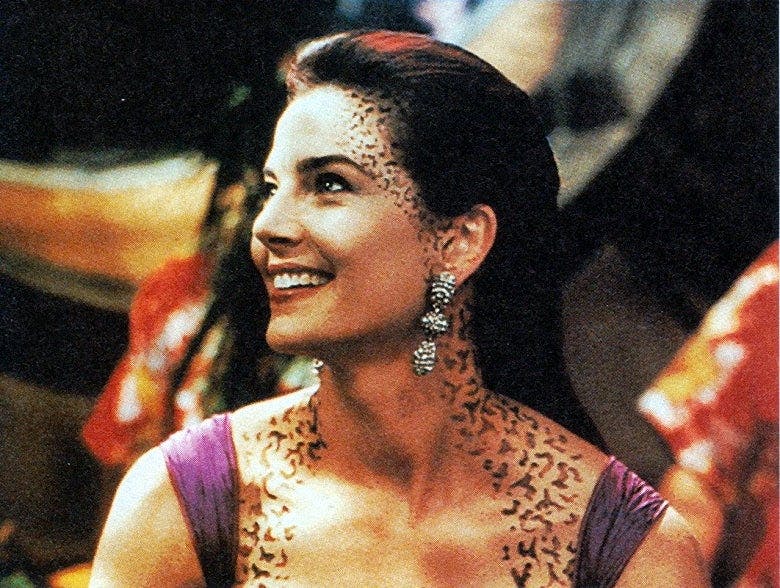
StarTrek.com
Deep Space Nine is widely regarded among fans to be the most subtextually queer version of life in Starfleet – so much so that it definitely deserves its own, more thorough exploration. Part of that comes from the inclusion of Dax, a Trill officer whose previous host was Commander Benjamin Sisko’s elderly male mentor and who takes on different female forms over the course of the series. As Jadzia, Dax engages in the first same-gender kiss on Star Trek in “Rejoined,” after reconnecting with the wife of a former host. When new host Ezri is introduced in Season 7, her mirror universe counterpart is implied not to have any interest in relationships with men at all in "The Emperor’s New Cloak” – instead she seeks out both the Intendant and a Mirror version of Leeta, and the two are later portrayed as spouses in a non-canonical tie-in novel, Rise Like Lions.
These days, however, the creators of Deep Space Nine freely acknowledge that they could have done more to elevate LGBT representation – not with Dax, but with the Cardassian spy-turned-tailor, Garak, who actor Andrew Robinson deliberately played as being much more than platonically interested in Doctor Julian Bashir.
“I wish we could have done a little more with the Garak character,” showrunner Ira Steven Behr told Comicbook.com in an interview while promoting his documentary What We Left Behind: Looking Back at Star Trek: Deep Space Nine. “I talk about it in the doc. I mean, he was clearly gay or queer or however you want to say it. I think I would have loved to have taken that and seen where that went and how that affected his relationship with Bashir.”
Star Trek: First Contact
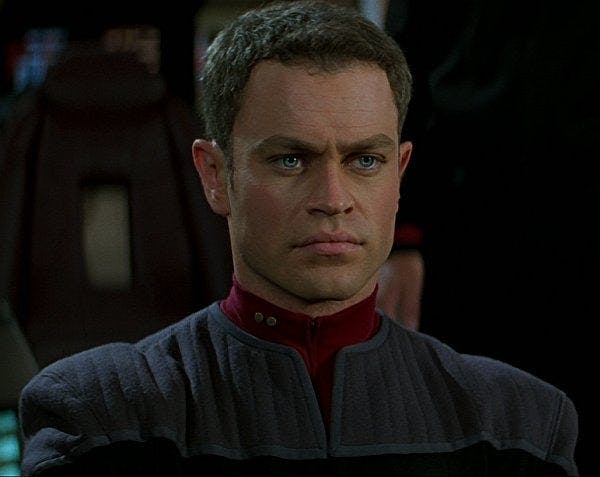
StarTrek.com
According to fan rumors, early drafts of the screenplay for Star Trek: First Contact made some mention of a minor character, Lieutenant Hawk, being gay, which was quickly denied by producer Rick Berman (a supposed first draft that surfaced online refers to Hawk as a naive young Ensign, not a Lieutenant). In any case, Hawk’s identity was eventually made more overt in Section 31: Rogue, a non-canonical, prequel tie-in novel that depicts him as being romantically linked to other male Starfleet officers.
Of course, Hawk is also assimilated by the Borg and killed before First Contact ends, which dips into some unfortunate trope-filled territory for LGBT+ characters who are often treated as more expendable than straight ones.
Star Trek: Voyager
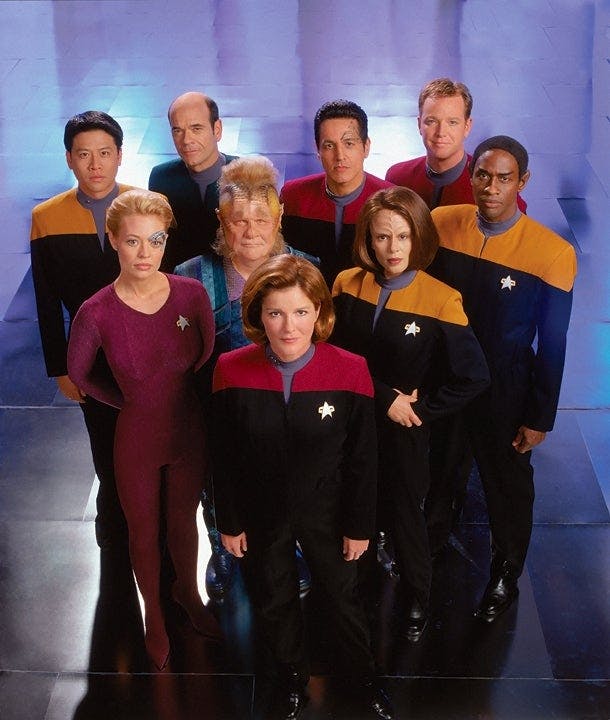
StarTrek.com
After The Next Generation ended in 1994, Voyager was both the next tentpole for the franchise and a flagship series for Paramount’s brand-new TV channel, UPN. As such, the show got a lot more attention and scrutiny from fans and producers alike (which, to hear Ira Steven Behr tell it, is part of the reason Deep Space Nine got away with so much).
While Voyager never explicitly featured a gay character, there were certainly behind-the-scene conversations about doing so. As Voyager writer (who would go on to create Star Trek: Discovery before leaving the project in 2017) Bryan Fuller told AfterEllen.com in 2006:
“There was a pregnant ensign – Ensign Wildman – and she was going to have gay godparents to her child,” said Fuller, explaining the show’s potential plotline – that never got made. But Fuller found the characters so two-dimensional that he wasn’t disappointed it didn’t air: “It sounds weird to say – but I was kind of glad they didn’t do it the way it was written. Because it became really cliché.”
In 1996, a group of science fiction writers, fans, and activists associated with the San Francisco Bay Area Chapter of the Gay & Lesbian Alliance Against Defamation launched an online petition known as the “Voyager Visibility Project,” which at its height gathered more than five thousand signatures from fans in every U.S. state and 26 different countries. The group even secured the support of Roddenberry’s step-grandson, Richard Comton Jr., who said in a public statement: “Gene Roddenberry promised us representation on Star Trek, where is it? Must there be closets in the 23rd Century, too?"
As was the case with Lieutenant Hawk, the Voyager tie-in novels often boldly went where the show would not, albeit only with ancillary characters; Harry Kim’s roommate at Starfleet Academy is portrayed as gay in Pathways and there are several same-gender couples depicted in passing throughout the book.
In 2002, after Voyager had ended, actor Kate Mulgrew spoke about having brought the issue up to Rick Berman at the time:
“I've approached [Rick] many, many times over the years about getting a gay character on the show — one whom we could really love, not just a guest star. Y'know, we had Blacks, Asians, we even had a handicapped character — and so I thought, this is now beginning to look a bit absurd. And he said, "In due time." And so, I'm suspecting that on Enterprise they will do something to this effect. I couldn't get it done on mine. And I am sorry for that.”
Star Trek: Enterprise
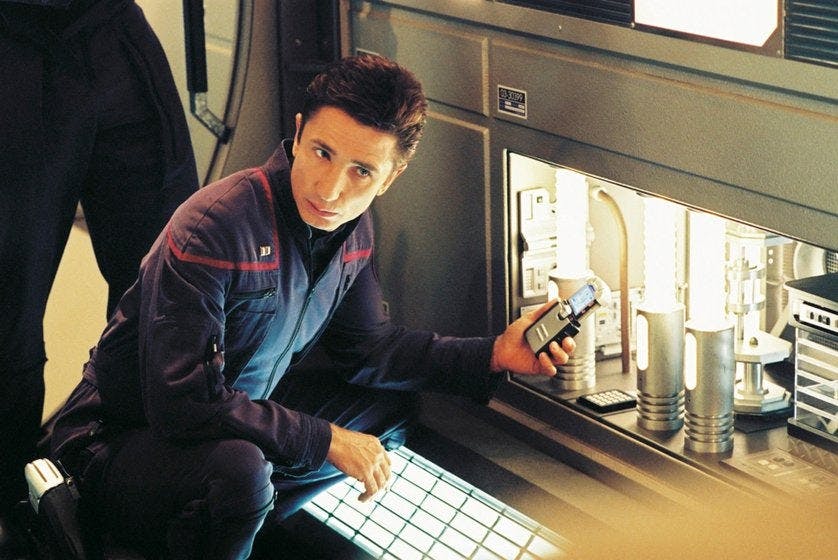
StarTrek.com
Despite Mulgrew’s suspicions, Enterprise didn’t fare much better than Voyager did. Rumor had it in 2001 that Dominic Keating’s character, Malcolm Reed, would be written as gay, but it never came to pass (although Keating has since made jokes about having played him that way).
Which isn’t to say that Enterprise never played with sex and gender – it just did so in the same way that TNG before it did, veiled through metaphors and alien cultures, In “The Cogenitor,” a Season 2 episode that evokes TNG’s “The Outcast,” Commander Charles Tucker III befriends a genderless, uneducated slave who is given to a Vissian couple to facilitate childbirth, almost like a Handmaid of Gilead. Although the episode contains no trace of a romantic connection between Tucker and “Charles” (they eventually name themselves after Tucker) like the one that Riker and Soren shared, it is notable for featuring a male performer in a role marked by subservience, marginalization, and reproductive rights.
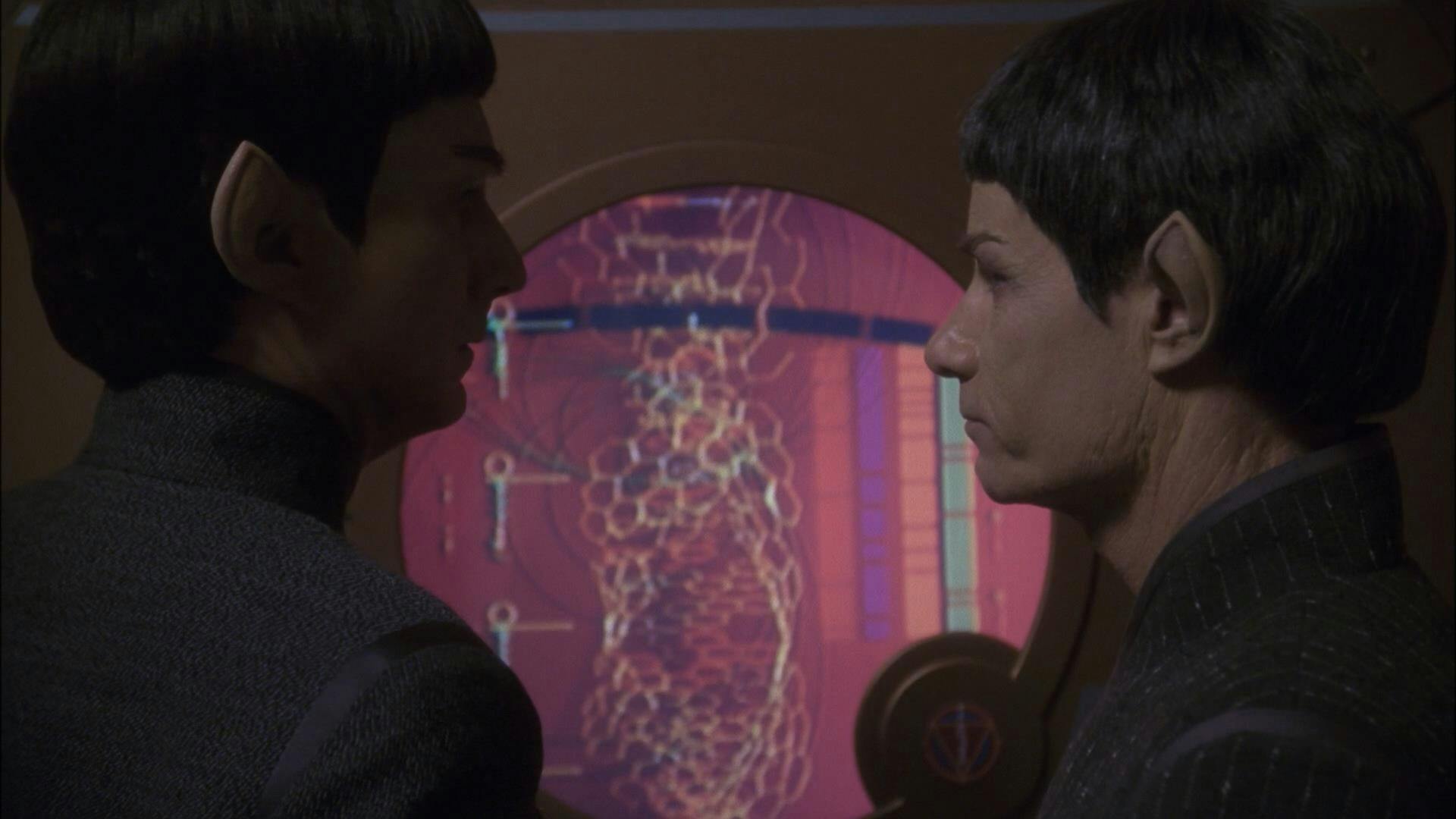
StarTrek.com
That same season, Enterprise also tried its hand at an episode about HIV, as did many other Paramount-owned television productions as part of Viacom’s “KNOW HIV/AIDS” PSA campaign. Of course, the visible gay representation that “Blood and Fire” episode would have given to TNG was not present here – instead, the episode, ”Stigma,” revolved around T’Pol contracting a degenerative Vulcan illness through a mind-meld, which at this point in Star Trek’s timeline was considered taboo.
“How you're infected shouldn't matter,” actor Scott Bakula told HIV Plus Magazine about the episode. “That's the lesson we all had to learn in this country. Here, AIDS was originally a gay disease, and certainly in the middle of the country that's how it was widely perceived and sometimes still is perceived to be. But it's an issue that affects everybody.”
Star Trek: Beyond

StarTrek.com
Although the J.J. Abrams-produced Star Trek reboots weren’t set in the same timeline as the official canon of previous series and films, they did collectively rake in upwards of $1.2 billion at the box office, so of course the news that Star Trek Beyond would feature the first gay character in the franchise made national headlines. The excitement compounded further when it was revealed that the character in question was already known to fans – Hikaru Sulu, the character once played by George Takei, was depicted holding hands with a husband (played by co-screenwriter Doug Jung) and a young daughter.
“I liked the approach, which was not to make a big thing out it, which is where I hope we are going as a species, to not politicise one’s personal orientations,” actor John Cho told the Herald Sun, noting that director Justin Lin wanted to nod to Takei’s real-life struggles with acceptance and gay rights activism.
While the intentions were certainly good, reactions were mixed. For his part, Takei expressed public concerns that retroactively making his character gay did more harm to the show’s legacy than good. Others wanted to see something more substantial from Star Trek’s first gay officer than a small detail in the background of a scene – especially when actor John Cho revealed that a “welcome home“ kiss was cut from the final edit. Still, for many fans who’d been waiting to see themselves represented in Trek for their entire lives, it was a step forward in the right direction.
Star Trek: Discovery

StarTrek.com
From the second that Star Trek: Discovery was first announced in 2015, it was a safe bet that the new series would finally be correcting the five-decade absence of LGBT characters in Starfleet. “Absolutely, we’re having a gay character,” series co-creator Bryan Fuller said at the Television Critics Association conference in 2016. “Alex Kurtzman, the straight man in the team, was telling me we would need a gay character.”
Fuller departed from the series in October of that year, but the show stayed true to his word. Not long after, it was revealed actor Anthony Rapp would play the first gay Star Trek character in a television series, Paul Stamets, and that Wilson Cruz would play his husband, Dr. Hugh Culber. The portrayal was not without its bumps – Culber’s death in Season 1 caused an uproar among fans, although he did eventually return – their love for one another has remained an integral element of series from the very first episode of Discovery.
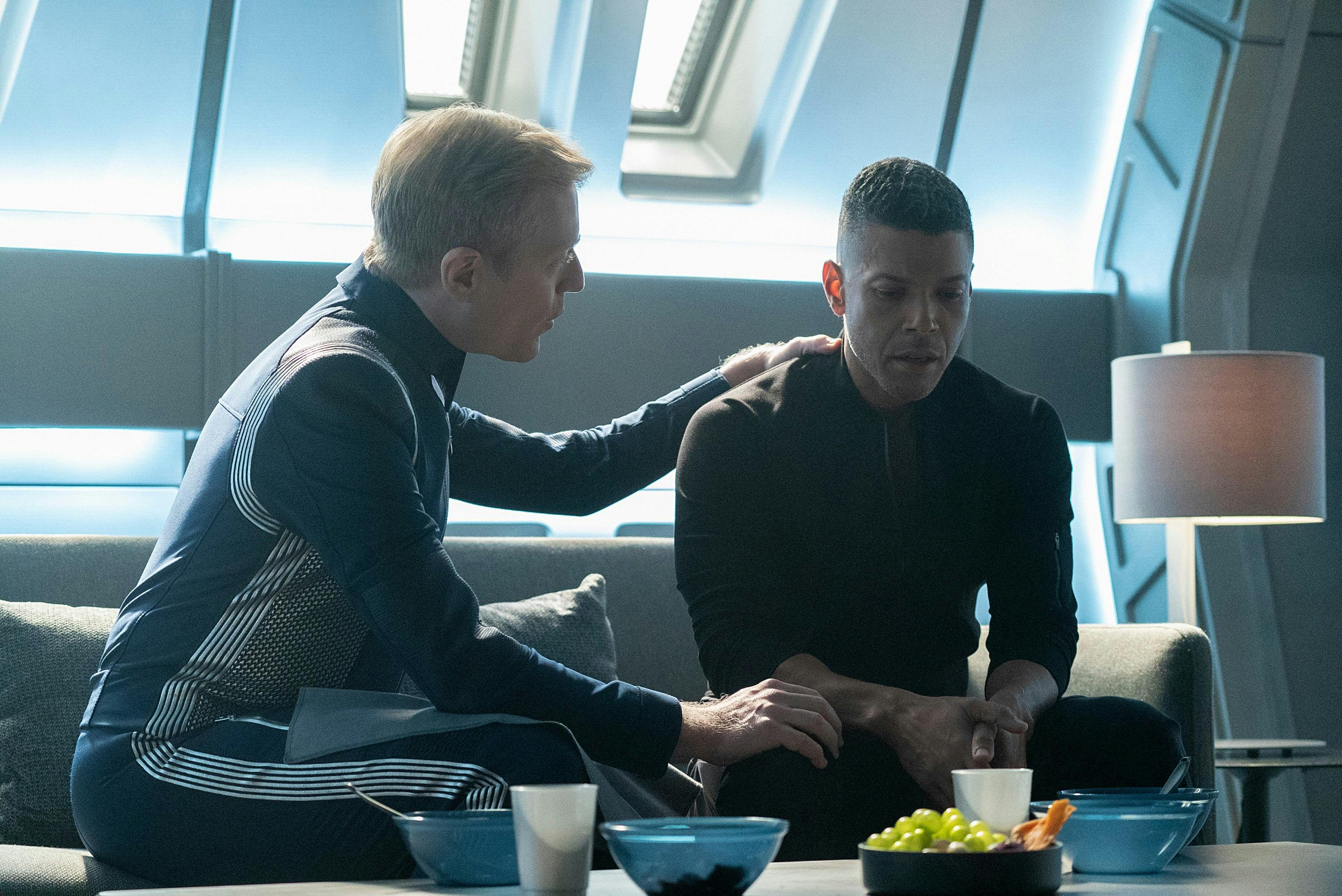
StarTrek.com
Possibly even more noteworthy than the appearance of queer characters, though, is how casually the show now treats their existence in the 22nd century. Wilson Cruz may have technically missed the boat on being the first gay man in Star Trek, but he is the first person to say the word out loud on the show – an incredulous “You do know he’s gay, right?” at Mirror Georgiou when she attempts to flirt with Stamets in front of him. “Don’t be so binary,” she shoots back.
In 1966 when Star Trek first aired, that conversation would have been inconceivable. Now, in 2019, it’s expected. Hopefully, Trek can continue to boldly push pop culture in more forward-thinking ways for even more decades to come – but with a more condensed timeline.
Victoria McNally (she/her) is a writer in Brooklyn and has a lot of opinions about skants. Find her online at victoriamcnally.com or at @vqnerdballs on Twitter and Instagram.

